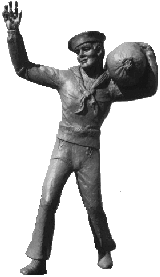|
ITHACA, N.Y. JOURNAL, DECEMBER 1991 By Beth Saulnier, Journal Staff
The brig project was originally slated to be the veterans' first commemorative effort. But when budget problems forced the state to withdraw its pledge of $65,000 for asbestos removal, the Salts decided to lower their sights and begin with a smaller memorial. "I had to do something for our membership," Bull says of the need for a tangible reminder of the Salts' military service. When a fellow veteran saw the bronze-finished fiberglass statue at the Newport, R.I., estate of famed sculptor Felix DeWeldon, Bull felt he'd found the perfect tribute to the Sampson trainees who took to the seas to serve their country. The Newport Navy League had commissioned the statue from the sculptor, who created the Iwo Jima Memorial, in 1984. However, when the league failed to raise the promised price of $200,000, DeWeldon repossessed the statue. After some negotiations, he agreed to sell it to the Salts for $12,000. Bull drove to Newport in a U-Haul and brought the sailor back for a dedication ceremony attended by the artist, veterans and state officials. "You saw grown men cry," Bull remembers. With the sailor now a permanent part of the Sampson landscape, the veterans are working to get the museum project off the ground. Two years ago, Bull and two friends hung a sign proclaiming the brig's future purpose on its imposing barbed-wire fence. So far, no other changes have been made to the building. Still, the veterans are determined to make their dream a reality. "We have the stuff stored all over the place now," says Bull, who has uniforms, flags and period photographs stashed in his garage in anticipation. The brig one housed people who didn't keep their noses clean," Bull says. The spartan brick building had different accommodations for serious offenders than for those who were caught drinking, or off-base without permission. The Salts hope to turn the abandoned jail into a showcase for period artifacts; the $600,000 plan includes a complete renovation and a glass atrium over the brig courtyard. Bull's lifelong association with Sampson began when he joined the Navy on his 17th birthday. The veteran, who now lives in Seneca Falls, was one of the first recuits to arrive at Sampson in the fall of 1942. The training station cost $56 million and covered 2,500 acres on the eastern shore of Seneca Lake. The facility contained 400 buildings and could accommodate 40,000 future sailors at once. A total of 411,429 men and WAVES trained there until it closed in 1946. About 30 concrete and brick structures still stand on the site; the wooden structures have long since disintegrated. Both the Air Force and the Army have used the facility, which once served as a two-year veterans college. Now campers congregate in sight of the old supply buildings, and pleasure boats moor where the sailors once learned to row. Bull first arrived at Sampson by train. He left the same way, three months later, without ever having stepped off the station. Pointing to a cluster of abandoned buildings amid scruffy trees and waist-high grass, Bull remembers being processed after arrival. "They stripped you down, and gave you a cardboard box to mail all the stuff you came in back home," Bull says. For 90 days, Bull and his comrades rose at 5 a.m. and marched to the "galley" for breakfast. They spent their days learning the basics of seamanship, including riflery, naval history and knot-tying. At the end of the training period, about half went directly into active sea duty. The others, like Bull, were sent to specialized training schools. Bull went to Norfolk, Va., to become a pharmacist's mate. He eventually served on an LST, Landing Ship Tanks, which carried tanks to the shores of Pacific islands, including Okinawa. The Sampson veterans first organized in 1987. The group boasts more than 3,000 veterans and their families, and constantly adds new members. Most Salts live in the Northeast, but members are scattered all over the country. The group holds an annual meeting at the station - more than 1,000 people attended this year - as well as regional gatherings around the United States. The Salts will celebrate their fifth birthday next fall, as well as the 50th anniversary of Sampson's opening. Bull is busily masterminding a gala reunion, complete with a 1940s-style USO show.
|
||||||||
